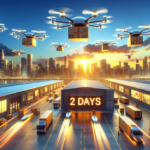Amazon Expands Its Shipping Empire: Implications for Consumers and the Retail Landscape
Over the past few years, Amazon has aggressively expanded its shipping capabilities, positioning itself as a formidable competitor to traditional retailers. With an extensive network of warehouses, cutting-edge technology, and innovative delivery methods, the e-commerce giant offers faster and more convenient delivery options to customers worldwide. This article delves into Amazon's shipping strategy, its impact on consumers, and the broader retail industry.
Amazon's Shipping Strategy: A Pillar of Future Success
Enhancing Customer Satisfaction and Loyalty
Amazon's shipping strategy goes beyond mere delivery; it's integral to the company's business model focused on customer satisfaction and loyalty. By providing quick and reliable shipping options, Amazon encourages repeat business, even if it means customers pay a premium for convenience.
Cost Control and Operational Efficiency
By managing its own shipping network, Amazon reduces reliance on third-party carriers like UPS and FedEx. This autonomy allows the company to lower shipping costs and maintain stringent control over the customer experience, resulting in more competitive pricing and enhanced service quality.
Innovative Delivery Methods
Amazon continuously explores new delivery technologies, including drone delivery and Amazon Locker, to boost convenience and reduce operational costs. These innovations not only enhance customer experience but also streamline the delivery process.
Sustainability Initiatives
Committed to achieving net-zero carbon emissions by 2040, Amazon invests in electric delivery vehicles and renewable energy sources. These efforts aim to minimize environmental impact while meeting the growing consumer demand for sustainable practices.
Competition with Traditional Retailers for Shipping Dominance
Retailers Enter the Shipping Race
Amazon's dominance has prompted traditional retailers like Walmart and Target to enhance their own shipping capabilities, introducing services such as free two-day shipping and in-store pickup to remain competitive.
Technological Advantages
Amazon's investment in automation and data analytics provides a significant edge. Advanced technologies enable the company to optimize shipping operations, reduce costs, and maintain high service standards that many competitors struggle to match.
Prime Membership as a Competitive Edge
The Amazon Prime program, offering benefits like free two-day shipping, plays a crucial role in attracting and retaining loyal customers. Prime membership fosters a recurring revenue stream and strengthens customer allegiance.
Transformation of the Retail Industry by Amazon's Logistics Network
Revolutionizing Convenience and Speed
Amazon's vast logistics network allows for unprecedented levels of convenience and speed. Features like same-day and two-hour delivery in select cities have set new consumer expectations, compelling other retailers to elevate their delivery offerings.
Driving Industry-Wide Innovation
The push for faster and more efficient delivery has spurred innovation across the retail sector. Investments in automation, robotics, and data-driven logistics are transforming how goods are stored, handled, and delivered.
Expansion into Diverse Markets
Amazon's logistics prowess has facilitated its entry into various markets, including grocery delivery and healthcare. This diversification disrupts traditional retail models, forcing competitors to adapt or risk obsolescence.
Pros and Cons of Amazon's Aggressive Shipping Expansion
Advantages for Consumers
Consumers benefit from faster and more reliable shipping options, leading to increased satisfaction and loyalty. The convenience of receiving products swiftly enhances the overall shopping experience.
Challenges for Small Businesses
Amazon's shipping dominance can pose significant challenges for small businesses and independent sellers. Competing with Amazon's delivery speeds and pricing may be difficult, potentially limiting market access for smaller players.
Environmental Concerns
The surge in shipping volume raises environmental issues, including increased carbon emissions and packaging waste. While Amazon invests in sustainable practices, the overall environmental impact remains a concern.
Enhancing Delivery Speeds and Customer Experience
Investment in Advanced Technologies
Amazon is at the forefront of adopting technologies such as drones and autonomous vehicles to revolutionize delivery methods. These technologies promise to reduce delivery times and operational costs significantly.
Data-Driven Improvements
By leveraging data analytics, Amazon continuously refines its shipping processes. Analyzing customer feedback and delivery metrics enables the company to identify and address areas for enhancement, ensuring optimal service quality.
Expansion of Fulfillment Centers
Strategically located fulfillment centers allow Amazon to store products closer to customers, minimizing delivery times and reducing costs. This network expansion supports the growing demand for expedited shipping services.
Impact on Small Businesses and Independent Sellers
Access to a Broader Market
Using Amazon's shipping services can enable small businesses to reach a wider audience, facilitating growth and increased sales opportunities.
Operational Efficiency
Amazon's logistics expertise can help small sellers streamline their operations, reducing costs and improving delivery reliability, which is crucial for scaling their businesses.
Building Consumer Trust
Association with Amazon's reputable shipping services can enhance the credibility of small businesses, making consumers more likely to purchase from sellers they perceive as reliable and efficient.
Future Expectations for Consumers
Continued Advancements in Delivery
Consumers can anticipate even faster and more reliable shipping options as Amazon invests in new technologies and expands its logistics network.
Enhanced Prime Membership Benefits
Prime members may enjoy additional perks such as free same-day delivery, exclusive discounts, and other incentives designed to enhance the value of their membership.
Job Creation in Logistics
Amazon's expansion of its warehouse and delivery network is likely to generate new job opportunities in the logistics sector, benefiting local economies and job seekers.
Technological Innovations in Amazon's Logistics
Automation and Robotics
Amazon employs robots in its warehouses to sort and move packages efficiently, reducing the need for manual labor and enhancing operational speed.
Drone Delivery Initiatives
The company's exploration of drone technology for last-mile delivery aims to significantly cut down delivery times, particularly in densely populated urban areas.
Data Utilization for Shipping Optimization
Behavioral Analytics
By analyzing customer purchasing patterns and preferences, Amazon can optimize inventory placement and streamline the shipping process, ensuring timely deliveries.
Operational Metrics
Tracking delivery times and other key performance indicators allows Amazon to identify bottlenecks and implement solutions to enhance efficiency and customer satisfaction.
Prime Membership: Expanding Benefits
Current Benefits
Amazon Prime already offers free two-day shipping, access to streaming services, and exclusive deals, making it a valuable subscription for millions of customers.
Potential Future Perks
As Amazon's shipping capabilities grow, Prime members may receive additional benefits such as free same-day delivery, exclusive product launches, and personalized shopping experiences.
Long-Term Effects of Amazon's Shipping Dominance
Potential Displacement of Brick-and-Mortar Stores
Amazon's extensive logistics network could eventually overshadow traditional brick-and-mortar retailers, leading to significant shifts in the retail landscape.
Market Saturation and Competition
While Amazon currently leads in shipping and logistics, increasing competition and market saturation may influence its growth trajectory and operational strategies.
Evolution of Retail Models
The ongoing transformation driven by Amazon's logistics innovations is likely to result in the emergence of new retail models, blending online efficiency with in-store experiences.
In conclusion, Amazon's aggressive expansion in shipping and logistics is reshaping the retail industry, offering numerous benefits to consumers while presenting challenges for traditional retailers and small businesses. As Amazon continues to innovate and invest in new technologies, its influence on the future of retail remains profound and multifaceted.






















